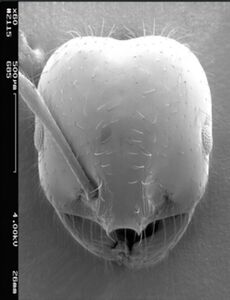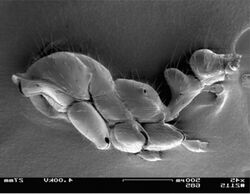Key to Solenopsis saevissima species group workers
This worker key is based on: Pitts, J.P., Camacho, G.P., Gotzek, D., McHugh, J.V., Ross, K.G. 2018. Revision of the fire ants of the Solenopisis saevissima species group (Hymenoptera: Formicidae). Proceedings of the Entomological Society of Washington. 120:308–411.
Identification of fire ants. The characters used here for the identification of fire ants are those normally used for myrmecological taxonomic work. The most useful characters for the workers are size, coloration, head shape, and postpetiolar shape. After thorough examination of males and gynes, we feel that the workers are superior to sexuals for distinguishing the various species. The gynes and males of many species are very similar and in some cases are indistinguishable between species without a reference collection. Some gyne characters such as pilosity or sculpturing are highly variable, as they are for workers, but sometimes can be useful. Size, coloration, and head shape are also of some use in identification of the gynes. Coloration and size of males tend to be very similar for many species, making these characters of limited value for identification purposes. Some species, however, have reliable male sculpture characters.
Geographical distribution can be useful for identifying fire ants but can be biased by several factors. As mentioned by Trager (1991), fire ants are easily transported to new regions, which makes geographical information valuable only as a complement to other data. Also, the available distributional data for most species are patchy and are almost certainly incomplete; therefore, some species could have much broader ranges than are reported here. On the other hand, occurrence records for fire ants are often incorrect due to misidentifications or habit of assigning specimens to the most common species (e.g., S. invicta or S. saevissima) and reported ranges can hence be grossly overestimated.
This key is not intended for the identification of minor workers. To fully utilize all of the available information and to obtain an accurate identification, one should take a sizeable sample of workers, males, gynes and larvae from a colony. Special effort should be made to obtain major workers. A positive identification may be impossible for colonies lacking such individuals, such as those sampled soon after founding. Tabular keys to the major workers, gynes, and males are presented in Tables (see publication). These should be consulted especially when a colony sample does not include representatives of all forms.
You may also be interested in
1
- Gyne and male: small, 5.0 mm or less in length; sculpture reduced, body polished; metapleuron fused to propodeum. Gyne: parapsidal lines absent; clypeus lacking longitudinal carinae and apical teeth; posterior margin of head broadly emarginated with posterolateral corners angulate (social parasites lacking workers) . . . . . 2
- Gyne and male: larger, greater than 5.0 mm in length; sculpture not reduced, present at least on propodeum, petiole and postpetiole; metapleuron not fused to propodeum. Gyne: parapsidal lines present; clypeus with longitudinal carinae terminating in teeth apically; posterior margin of head narrowly emarginated medially with posterolateral corners rounded (free living with workers) . . . . . 3
2
return to couplet #1
- Gyne: posterior margin of head angulate, lobate in lateral view. Distribution: south from Mato Grosso do Sul, Brazil to Buenos Aires Province, Argentina . . . . . Solenopsis daguerrei
- Gyne: posterior margin of head rounded, not lobate in lateral view. Distribution: Jacarepagua´, Rio de Janeiro, Brazil southwest to Rolandia, Parana, Brazil . . . . . Solenopsis hostilis
3
return to couplet #1
- Major worker: pronotum low and nearly flat or weakly convex in profile (see below); metasoma black, legs yellow (yellowish brown in darker specimens), head and mesosoma ranging from clear yellowish red with some black or brownish black markings in the occipital area to uniformly brownish black (especially in vicinity of Cochabamba, Bolivia). Distribution: northwestern Argentina to Bolivia in Andean foothills . . . . . Solenopsis electra
- Major worker: pronotum higher, angular or strongly convex in profile (see below); color variable but never with metasoma completely black and with yellow legs . . . . . 4
4
return to couplet #3
- Major worker: area immediately posterior and dorsal to metapleural spiracle finely punctate or striato–punctate; largest major workers with head strongly cordate. Male: weak to distinct mesonotal maculations present; ocelli moderate to large, OOI 0.80–1.26, normally OOI<1.00 (Fig. 65). Distribution: southern half of Mato Grosso, western Mato Grosso du Sul, Brazil . . . . . Solenopsis pusillignis
- Major worker: area surrounding metapleural spiracle shiny and smooth; largest major workers with head moderately to weakly cordate. Male: mesonotal maculations absent; male ocelli moderate to small, OOI > 1.00 . . . . . 5
5
return to couplet #4
- Major worker: posterior face of postpetiole as high or higher than broad (see below) . . . . . 6
- Major worker: posterior face of postpetiole broader than high (see below) . . . . . 11
6
return to couplet #5
- Major worker: pronotal dorsum in posterodorsal view medially concave; anterolateral bosses giving squared-off appearance to anterodorsal rim of pronotum (see below); head uniformly brownish black; mandibles usually brownish yellow; frons without dark median streak or this barely distinct from remainder of frons. Male: often with distinct tuberculate postpetiole, tubercle height ³ 1.5X width at base, tubercles glabrous; OOI < 1.35. Distribution: southeastern Brazil to central eastern Argentina; introduced into southeastern United States . . . . . Solenopsis richteri
- Major worker: pronotal dorsum in posterodorsal view usually flat or weakly convex; pronotum lacking anterolateral bosses (see below); or if bosses present, head yellowish, at least near mandibular bases and clypeus and often more extensively yellowish; Male: often lacking distinct tuberculate postpetiole, tubercle height £ 1.5X width at base, tubercles granulate or rugose; OOI > 1.4 . . . . . 7
7
return to couplet #6
- Major worker: median streak (frontal streak, fs) usually present. Gyne: mesonotal maculations present (gyne of S. weyrauchi was not examined) . . . . . 8
- Major worker: median frontal streak usually absent (see below). Gyne: mesonotal maculations usually absent . . . . . 10
8
return to couplet #7
- Major worker: large with DML exceeding 1.75 mm (sometimes over 2.0 mm) in largest workers of most series; piligerous foveolae small (<0.01 mm, see below). Gyne: if T1 maculation present, it sometimes has distinctly defined posterior margin. Distribution: normally lowlands species in western Argentina and Bolivia . . . . . Solenopsis interrupta
- Major worker: small with DML rarely in excess of 1.7 mm in even largest workers of most series (rarely up to 1.80 mm); piligerous foveolae large (0.005–0.03 mm, see below); Gyne: if T1 maculation present, it lacks a distinctly defined posterior margin (gyne of S. weyrauchi was not examined). Distribution: normally high elevation species . . . . . 9
9
return to couplet #8
- Major worker: cephalic piligerous foveolae small (<0.01 mm); rear face of postpetiole with striae present on lower 0.50–0.75 (see below); mandibles with 5–6 costulae; katepisternum of mesopleuron not or only weakly defined dorsally by finely striate furrow. Gyne unknown. Distribution: Peruvian, Bolivian, and Argentinian Andes, 2,000–3,500 m elevation . . . . . Solenopsis weyrauchi
- Major worker: cephalic piligerous foveolae large (0.01–0.03 mm); scape long, almost reaching the vertex of the head; rear face of postpetiole with striae present on lower 0.25–0.33 and smooth and shiny upper; mandibles with 10–12 costulae, weak to obsolescent medially; katepisternum of mesopleuron weakly to distinctly defined dorsally by finely striate furrow; promesonotal suture angulate medially, sometimes projecting upward; first sternite of gaster with anterior projections, visible in dorsal view. Gyne: large piligerous foveolae (0.01–0.03 mm) present on head; interfoveolar areas of head striate; ocellar triangle striate; median cell open by loss of m-cu cross vein; postpetiole glabrous on upper 0.75. Distribution: southern and southeastern Brazil, northeastern Argentina . . . . . Solenopsis metallica
10
return to couplet #7
- Major worker: larger, DML 1.4–l .6 mm (rarely 1.7 mm) in large workers; piligerous foveolae usually very small, inconspicuous. Gyne: cephalic pilosity approximately 0.30–0.33 mm long; metasoma pilosity arising from small, inconspicuous foveolae; median furrow on posterior 0.33 or less of mesonotum; bidentate metasternal process present. Larger species. Distribution: Orinoco drainage, Guianas, Amazonia and along rivers in bordering regions, also southeastern and eastern Brazil . . . . . Solenopsis saevissima
- Major worker: smaller, DML < 1.4 mm in even the largest workers; piligerous foveolae on head and pronotum sometimes conspicuous, 5–l0X as wide as base of seta. Gyne: cephalic pilosity about 0.15–0.20 mm long (Fig. 53); metasoma pilosity arising from conspicuous piligerous foveolae nearly or actually as large as those of head and mesosoma; median furrow on posterior 0.33–0.50 of mesonotum; bidentate metasternal process absent. Smaller and much rarer species. Distribution: Mato Grosso do Sul to southeastern Brazil and Misiones, Argentina . . . . . Solenopsis pythia
11
return to couplet #5
- Major worker: smaller, DML rarely in excess of 1.70 mm in even largest workers of most series; median (frontal) streak (fs) present (see below). Gyne: frontal streak present, sometimes faint; postpetiole usually completely sculptured, only extreme dorsum lacking striae. Male: head usually completely granulate, shagreened; gena moderately to coarsely rugose. Distribution: lowland species, western Amazonia, south through Mato Grosso, eastern Bolivia, Paraguay and southeastern Brazil to Santa Fe Province, Argentina; introduced into Southern United States . . . . . Solenopsis invicta
- Major worker: larger, DML exceeding 1.75 mm (up to over 2.0 mm) in largest workers of most series; median frontal streak usually absent. Gyne: median frontal streak usually absent; postpetiole usually completely sculptured, only highest portion lacking striae. Male: head usually incompletely granulate, glabrous anterolaterally of median ocellus, not shagreened; gena striate to granulate . . . . . 12
12
return to couplet #11
- Major worker: color mainly red to orange; mesosoma pilosity usually decumbent, not curved; transverse striae or rugae on rear face of postpetiole usually lacking, or faint, punctate or shagreened; outer surface of mandible usually shining medially, costulae obsolescent. Distribution: Uruguay, Entre Rios Province and adjacent parts of bordering provinces in Argentina; apparently introduced at Cochabamba, Bolivia . . . . . Solenopsis macdonaghi
- Major worker: color brown to nearly black; mesosoma pilosity erect, longest setae usually curved; sculpture on rear face of postpetiole with conspicuous transverse striae or rugae on lower 0.66–0.75, punctate or shagreened (see below); outer surface of mandible with costulae, sometimes obsolescent medially . . . . . 13
13
return to couplet #12
- Major worker: small with HL 1.45–l .55 mm; eye of largest workers relatively (and often absolutely) larger, REL 0.18–0.20 in large majors; head mostly dark brown to brownish black; in contrast, distal portion of clypeus, head near base of mandible, and (usually) area around dark median frontal sulcus distinctly lighter yellowish brown. Male: lateral faces of scutellum weakly to distinctly striate. Distribution: Buenos Aires and La Pampa Provinces, Argentina, Uruguay, north to Santa Catarina, Brazil . . . . . Solenopsis quinquecuspis
- Major worker: large with HL 1.6–1.75 mm in largest workers; eye of largest workers relatively (and often absolutely) smaller than above species, REL 0.16–0.18 in large majors; head uniform reddish brown or gradually fading anteriorly to a slightly lighter reddish brown; distal portion of clypeus, sides of head anterior to eye, and frons faintly or not at all chromatically distinct from posterior portions of head, median frontal streak absent or very faint. Male: lateral faces of scutellum glabrous. Distribution: Southern Brazil . . . . . Solenopsis megergates

















